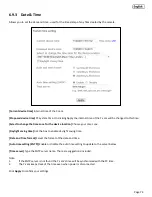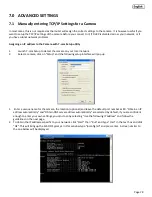
Page 88
9.0 GLOSSARY OF TERMS
Adhoc Mode: A wireless network system in which devices communicate directly with each other, without the use of a
wireless router.
DDNS: DDNS is a method of keeping a domain name linked to a dynamic IP address with your Network Camera. You can
set up your DDNS service and the device will automatically update your DDNS server each time it alter a different IP
address.
DHCP: Dynamic Host Configuration Protocol is a set of rules used by communications devices such as a computer, router
or network adapter to allow the device to request and obtain an IP address from a server which has a list of addresses
available for assignment.
Firmware: The firmware is the software in your Y-cam that makes the hardware functional and allows you to use the
many features of your wireless IP Camera
FTP: File Transfer Protocol. Network cameras equipped with an embedded operating system, such as Linux, can use FTP
to send images to a website.
Gateway Address: IP address of the gateway through which the IP camera is connected
IEEE 802.11b/g: The specifications developed by the IEEE for wireless network technology. It provides 11 Mbps
transmission in the 2.4GHz band usage.
Infrastructure Mode: One of the wireless network system in which devices communicate with each other by first going
through the wireless router.
IP Address: The unique 32 bit number assigned to each computer connected to the Internet. IP numbers are used by the
TCP/IP protocol to route packets of data to their destinations.
JPEG: A standard image format, used widely for photographs, also known as JPG.
Network Camera: A stand-alone device which allows users to view live, full motion video from anywhere on a computer
network, even over the Internet, using a standard web browser.
Primary DNS: IP address of the primary DNS server, if configured for the IP camera
Subnet Mask: Subnet mask of the LAN to which the IP camera is connected
TCP/IP: The collection of "protocols" underlying the functioning of the Internet. Each computer connected to the
Internet is identified by a unique IP Address.
Time server: A time server consists of a computer networking device that reads the actual time from a reference clock
and distributes this information to its clients using a computer network.
UPnP: Universal Plug and Play is architecture for pervasive peer-to-peer network connectivity of intelligent appliances
and wireless devices.
WEP: Wireless Equivalent Privacy. A security protocol for wireless network defined in the IEEE 802.11b/g standard. WEP
aims to provide security by encrypting data over radio waves so that it is protected as it is transmitted from one end
point to another.

































